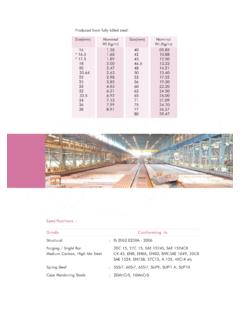Transcription of Experimental studies on the microstructure and …
1 Experimental studies ON THE microstructure AND HARDNESS OF LASERTRANSFORMATION HARDENING OF LOW ALLOY STEELP urushothaman Dinesh Babu1, Gengusamynaidu Buvanashekaran2, Karupuudaiyar R. Balasubramanian11 Department of Mechanical Engineering, National Institute of Technology, Tiruchirappalli, TN, India2 Welding Research Institute, Bharat Heavy Electricals Limited, Tiruchirappalli, TN, IndiaE-mail: March 2012, Accepted November 2012No. 12-CSME-38, Accession 3358 ABSTRACTAn Experimental investigation with Nd:YAG laser system was carried out to study the effects of laserhardening process parameters on the microstructure and hardness during laser hardening of EN25 laser beam is allowed to scan on the surface of the work piece by varying the laser beam power(750 1250 W) and travel speed (500 1000 mm/min) of the work table. The microstructural features ofthe laser hardened EN25 steel were analysed using optical microscope.
2 The microstructure of the surfacelayer was found to consist of plate martensite. A substantial increase in surface hardness was achieved, by afactor of 2 times the base material :laser transformation hardening; hardened depth and width; hardness; microstructure ; powerdensity; low alloy steel . TUDES EXP RIMENTALES SUR LA microstructure ET LA DURET AU COURS DUDURCISSEMENT PAR TRANSFORMATION LASER D UN ACIER FAIBLEMENT ALLI R SUM Une enqu te exp rimentale utilisant le syst me laser Nd :YAG a t r alis e pour tudier les effets des pa-ram tres d un proc d de durcissement par laser sur la microstructure et la duret au cours du durcissementd un acier EN25. On permet au faisceau laser de balayer la surface de la pi ce usiner en faisant varier lapuissance du faisceau laser (750 1250 W) et la vitesse de d placement (500 1000 mm/min) de la table detravail. Les caract ristiques microstructurales de l acier EN25 durci par laser ont t analys es en utilisantun microscope optique.
3 On a constat que la microstructure de la couche de surface se compose de plaquesde martensite, et on a r alis que la duret de la surface du mat riau de base a t augment e de mani resubstantielle, d un facteur de s :durcissement par transformation laser ; profondeur et largeur du durci ; duret ; microstructure ;densit de puissance ; acier faiblement alli .Transactions of the Canadian Society for Mechanical Engineering, Vol. 36, No. 3, 20122411. INTRODUCTIONS urface microstructure and composition play a crucial role in determining the surface dependent engi-neering properties (wear, corrosion and oxidation resistance) of a component. Surface engineering aimsat orientation of the microstructure and composition of the near surface region of the component withoutaffecting the bulk material. Traditionally, surface treatment processes like (flame hardening, induction hard-ening, carburizing, nitriding, carbonitriding and different hard facing techniques) are commonly employedin enhancing the wear resistance property of Fe-based component.
4 The conventional surface treatment pro-cesses posses several limitations, , high time and energy consumption, complex heat treatment schedule,wider heat affected zone, lack of solid solubility limit and slower kinetics. Furthermore, few of the abovementioned techniques are not environment friendly [1]. On the other hand, when a high power laser beam isused as a source of heat for surface treatment, it will avoid most of the limitations as observed in conventionalsurface treatment [2,3].Laser transformation hardening (LTH) is the process used for producing a hard, wear resistant surface oncomponents through the action of a scanned laser beam. As the heating duration is short, the hardened zonepresents less distortion and surface oxidation than that obtained in flame or induction hardening. Figure 1shows the distribution of hardness values obtained after laser hardening as compared to induction higher values for laser hardening near the surface are due to the much finer and highly restrainedmartensites in the laser-hardened microstructures compared to the other case [4].
5 LTH process is suitablefor selective surface treatments and is primarily used in steels with sufficient hardenability for improvementof wear resistance and fatigue strength [5 7]. Cast iron, medium-carbon steel and tool steel can be laserhardened to increase their wear and corrosion resistance [8,9].Fig. 1. Hardness distribution comparison between laser hardening and induction hardening [4].High-strength medium carbon low-alloy steels like EN25 are designed to provide better mechanical prop-erties and greater resistance to atmospheric corrosion than conventional carbon steels. They are not consid-ered to be alloy steels in the normal sense because they are designed to meet specific mechanical propertiesrather than a chemical composition. These steels are ordinarily quenched and tempered to specific hardness,but for critical applications it may be necessary to surface hardened without any distortion.
6 High strengthsteels are structural steels with yield strengths that can exceed 1380 MPa. The product forms include billet,bar, rod, forgings, sheet, tubing, and welding wire [10]. To ensure the high hardness and wear resistance ofthe working surface layers of machine components, it is necessary to use treatment with high concentrationenergy sources, in particular, laser treatment. The tribological properties and the durability of automobilecomponents such as camshafts, crankshafts, brake drums, internal combustion engine valve and valve seatand gears were improved by this method [11].242 Transactions of the Canadian Society for Mechanical Engineering, Vol. 36, No. 3, 2012 Laser sources can provide a controllable low heat input and high density energy deposition in the selectedareas for producing thin hardened surface layers. When a laser beam impinges on the surface of a workpiece,part of its energy is absorbed by the surface and suddenly turns into thermal energy.
7 If this absorbed energyis high enough, heat is generated in this region at a rate higher than the rate at which it flows to the bulkof the material by conduction. In these circumstances, the temperature of the surface layers increases veryquickly and in this region austenitization may occur, being the bulk temperature of the material essentiallyunaffected. Moving the workpiece with respect to the laser source, a region on the surface of the workpiecewithin the beam track is rapidly heated by the laser source, and is rapidly cooled by heat conduction to thebulk of the material after the beam has passed. The heating and cooling of the metallic material may besuitably controlled in order to allow hard martensite to form at the surface by laser treatment [12,13].The LTH process is competing now against the most widely used flame and induction hardening meth-ods. The process presents considerable advantages over these alternative methods.
8 The most significantare high degree of controllability and automation, low part distortion and capability of very selective andprecise treatment [14]. Due to the small volume of the treated material, contained in a few millimeters foreach path, the transition zone is small and the distortion is minimum. Hence laser transformation hard-ening is becoming the optimal technological solution for the laser surface treatment of small and 2 shows the maximum hardness of the steels including different carbon content. The broken lineindicates the hardness after conventional heat treatment. The tendency is also found to increase the hardnessup to a carbon content of and to maintain constant value of more than carbon content afterthe laser heat treatment. Especially, the hardness after this heat treatment indicates higher values (50 HV)than conventional one in the case of less than carbon content [15].
9 The advantages of using laser forsurface processing results from its highly directional nature and the ability to deliver controlled amountsof heat energy to desired regions. The energy input is dependent on the absorptivity of the material. Onlya fraction of the laser energy is absorbed by the material and the remaining portion is reflected from thesurface. The absorption of a polished metal surface depends strongly on the wavelength of irradiation. Inthe case of steels, the absorptivity increases when the wavelength is short. The wave length of Nd:YAG laserbeam is m where as the CO2laser beam is m. So the Nd:YAG laser which is having shorterwave length is suitable for surface hardening of steel [16].Fig. 2. Relationship between carbon content and maximum hardness [15].From the literature survey, it is found that material AISI 304, AISI 440C, 2Cr13 martensitic stainless steel ,EN18, EN24, U13A, AISI 1045, AISI 420, AISI H13, AISI 4140, EN8, titanium, manganese steel etc.
10 , wereconsidered for laser transformation hardening process [17 19]. The EN25 steel , which is used for many highTransactions of the Canadian Society for Mechanical Engineering, Vol. 36, No. 3, 2012243temperature applications [10], is not yet taken for laser hardening analysis. So in this current work EN25steel is taken for laser processing and this will be useful for automobile, aircraft and transportation effect of the process on the hardened depth depends strongly on the process parameters used, as wellas on the thermo-physical properties of the material [20]. The major process parameters involved are laserbeam power and spot size, focal length, relative travel speed between the laser beam and the workpiece, andthe absorptivity of the surface to laser radiation [21,22].Laser transformation hardening is a method in which the high power laser beam quickly irradiates theworkpiece surface to increase rapidly the workpiece surface temperature that is higher than the austenitetransformation temperature and lower than the melting point.





